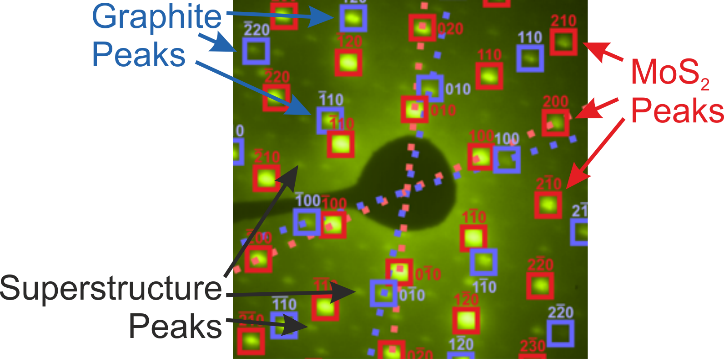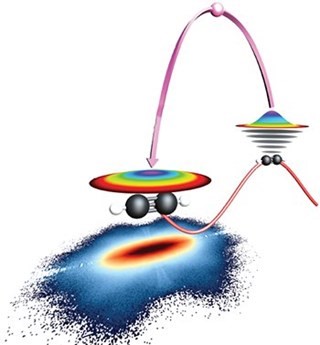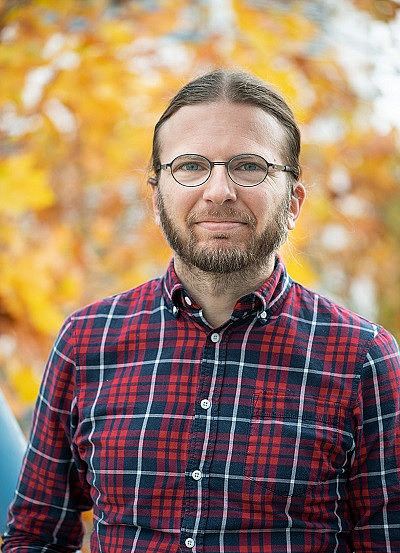Ultrafast structural dynamics
1. Coherent phonons in graphite
Our group is operating an ultrafast electron diffraction set-up capable to resolve atomic dynamics in a few nano meter thin crystals with a time resolution around 100 fs as reported by Gerbig et al (2015). Therefore, we excite the crystal with a femtosecond laser pulse and probe the structure of the lattice with an equally short electron bunch. Varying the time delay between both pulses allows to capture a “molecular movie” of the evolving crystal. Figure 1 displays a time-dependent diffraction intensity from a 9-layer (3 nm) thin graphite film. The clear oscillations with a period of 827 fs correspond to a coherent lattice vibration of the shearing type, where the atoms in adjacent layers of graphite oscillate with respect to each other.

2. (Ultrafast) diffraction of a 2D material heterostructure
2D materials such as graphite are crystals containing strongly bound planes that are stacked on top of each other with weak attraction. This makes it possible to create chemically stable atomically thin layers of these materials. Combining single layers of different 2D materials is a rapidly emerging research field and promises successful applications. We have succeeded to produce structures containing a few layers each of the 2D materials graphite and MoS2. Electron diffraction (figure 2) in transmission contains the diffraction peaks of the two individual materials but also so-called superstructure peaks that arise from the combination of the two systems. In Adrian et al (2016), we have demonstrated how the diffraction pattern can be used to characterize these combined 2D systems. Now we want to perform ultrafast electron diffraction measurements on such a MoS2‑graphite heterostructure to study the transfer of energy and lattice vibrations between the two materials when we excite only one of them.

Figure 2: Section of the diffraction pattern of a MoS2 graphite heterostructure containing the Bragg peaks of each material and additional peaks due to the superstructure formed of both lattices.
3. Laser-induced electron diffraction of a deprotonation acetylene cations
In collaboration with the group of Jens Biegert at the ICFO in Barcelona we have performed laser-induced electron diffraction of molecules in the gas phase. In this technique, an electron is emitted from a molecule inside a very strong laser field. The field accelerates the electron, then drives it back towards the molecule on which the electron scatters (figure 3). As in the diffraction measurements above, the scattering angle contains information on the structure of the molecule. With this approach we have investigated in Wolter et al (2016) how doubly charged acetylene molecules break into a proton and an ethynyl cation in the influence of a strong laser-field: When the molecular axis is parallel to the polarization of the light field, the deprotonation happens very rapidly: At the return time of the electron ~10 fs after ionization, one proton has already more than doubled its distance to the nearest carbon atom, while the second proton is staying close to its original position. For perpendicular alignment of the molecule at the same time, both protons have increased their distance do the carbon atoms slightly, but they are still bound. The protonation proceeds slower in this case.
Figure 3: An electronic wavepacket is emitted from an acetylene molecule (right) by a strong laser, then accelerated by its field and guided back to the molecule where it diffracts and creates a pattern containing structural information of the molecule (below).

Reference
Gerbig et al. (2015) C. Gerbig, A. Senftleben, S. Morgenstern, C. Sarpe & T. Baumert, New J. Phys., 17, 43050 (2015)
Adrian et al (2016) M. Adrian, A. Senftleben, S. Morgenstern & T. Baumert, Ultramicroscopy, 166, 9‑15 (2016)
Wolter et al (2016) B. Wolter, M. Pullen, A.-T. Le, M. Baudisch, K. Doblhof-Dier, A. Senftleben, M. Hemmer, C.-D. Schröter, J. Ullrich, T. Pfeifer, R. Moshammer, S. Gräfe, O. Vendrell, C. D. Lin & J. Biegert, Science 354, 308‑312 (2016)
Dr. Arne Senftleben
full member

- Telephone
- +49 561 804-4294
- arne.senftleben[at]uni-kassel[dot]de
- Location
- Universität Kassel
Heinrich-Plett-Str. 40
34132 Kassel
- Room
- 1126
